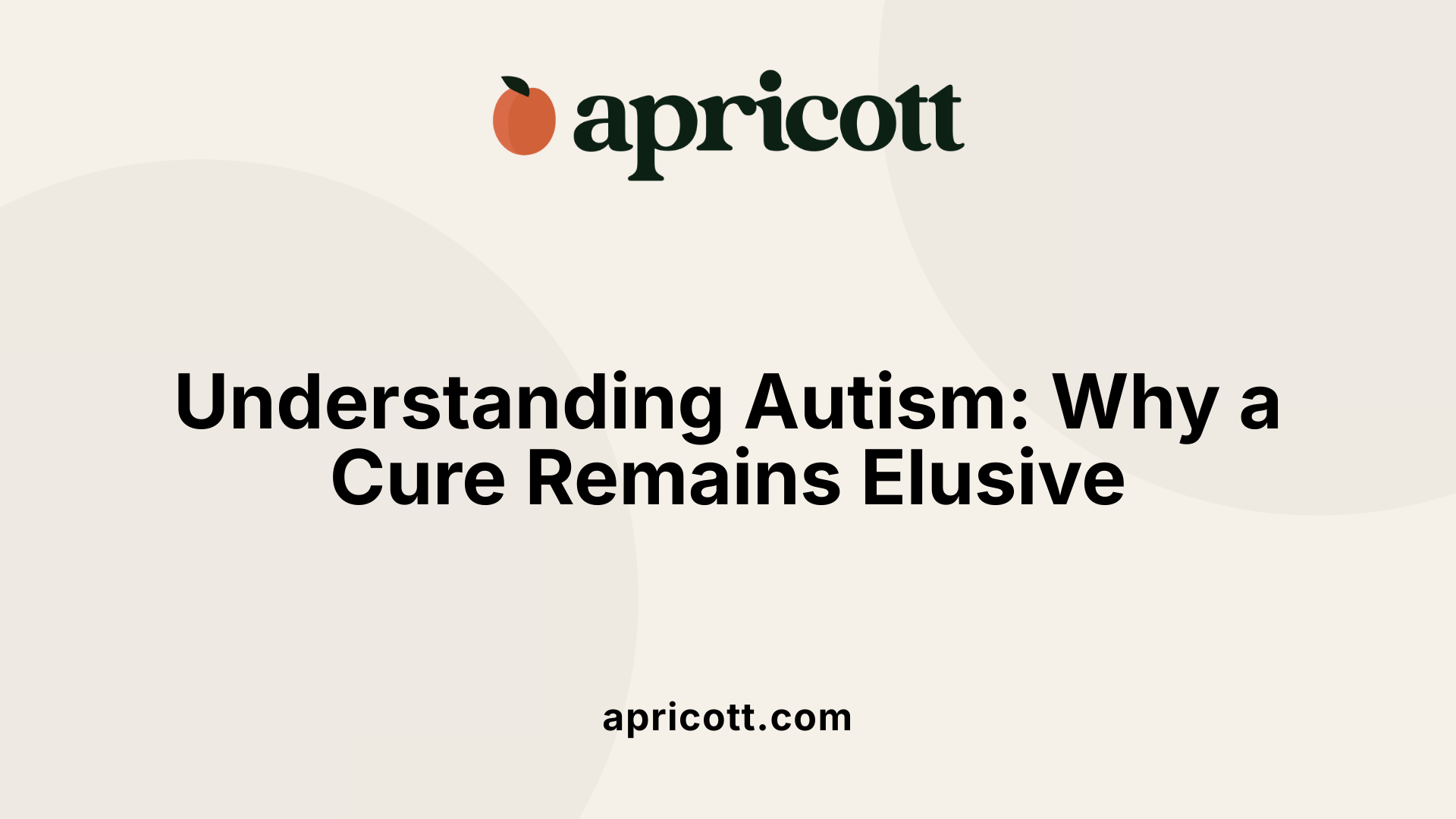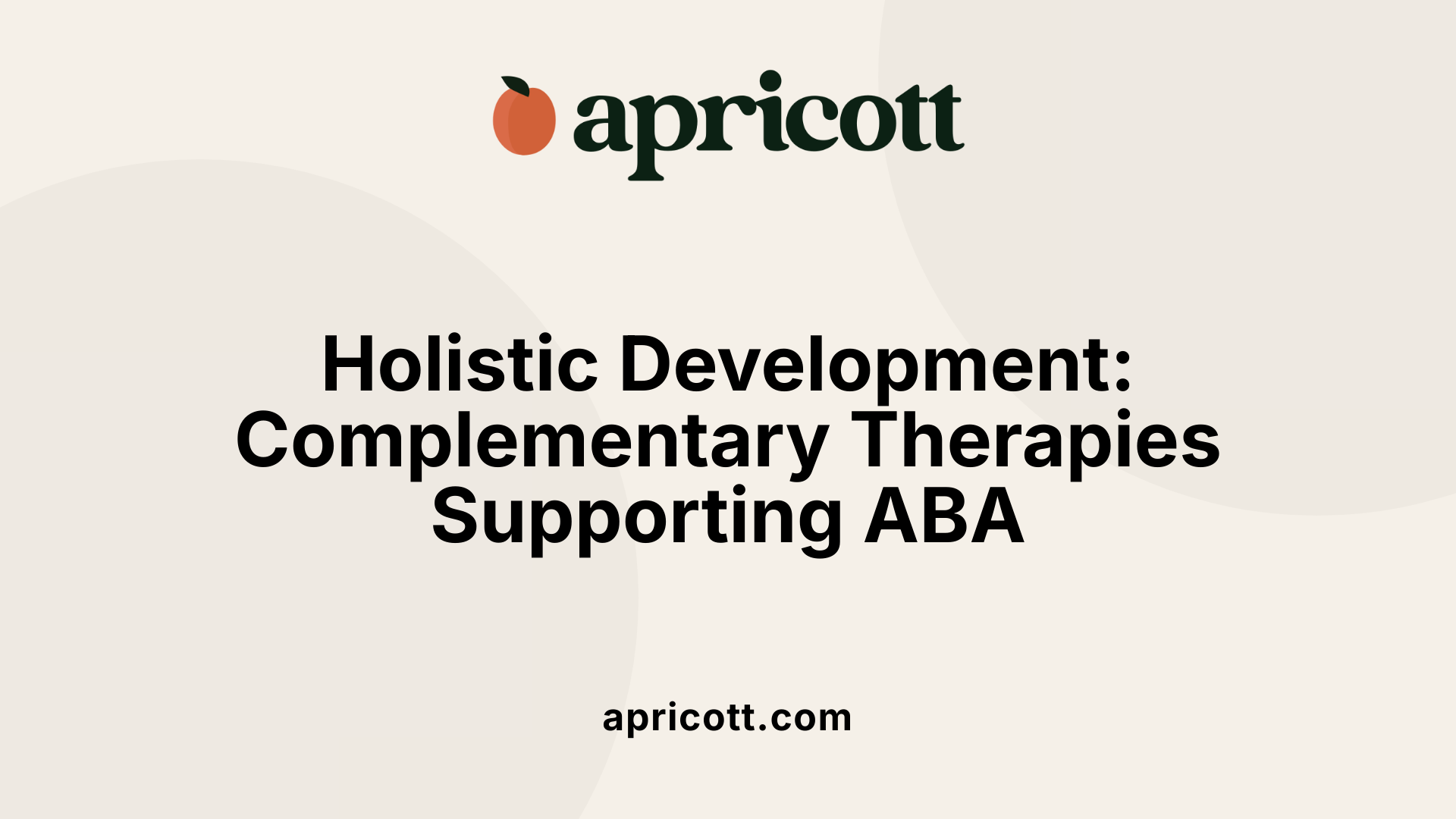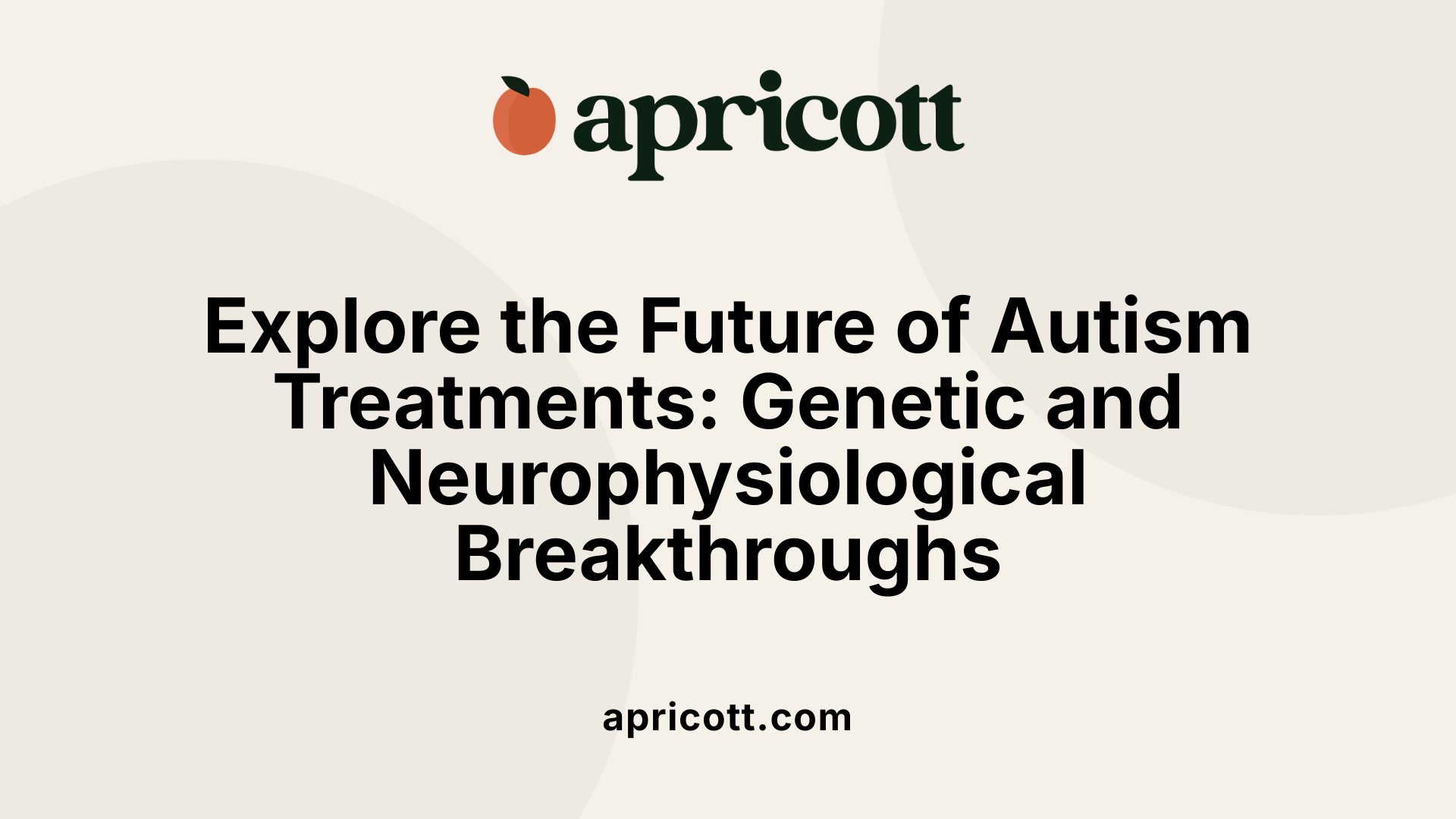December 2, 2025
Understanding Autism Spectrum Disorder: Treatments and the Question of a Cure
Autism Spectrum Disorder (ASD) is a complex neurodevelopmental condition characterized by differences in social communication, behavior, and sensory processing. As public awareness and diagnoses increase, many families and individuals face the pressing question: can autism be cured? This article explores current treatment approaches, emerging therapies, and the realities surrounding the concept of a 'cure' for autism.
Autism Spectrum Disorder (ASD) is a neurodevelopmental condition characterized by differences in social communication and interaction, alongside restricted, repetitive patterns of behavior, interests, or activities. It is called a "spectrum" because it presents with a wide range of symptoms and levels of severity.
The core features of ASD include challenges in social communication such as difficulties with verbal and nonverbal communication, problems in engaging with others, and understanding social cues. Additionally, individuals often exhibit restricted behaviors, including repetitive movements, insistence on sameness, or highly fixated interests. These traits affect daily functioning and vary between individuals.
ASD manifests differently in each person; some may have strong language skills but struggle socially, while others might have limited communication and more pronounced repetitive behaviors. This variability means treatment and support need tailoring to each individual's needs and abilities, emphasizing early diagnosis and intervention to maximize developmental outcomes.

Autism Spectrum Disorder (ASD) is a complex neurodevelopmental condition that affects how the brain develops and functions. Unlike illnesses caused by a single factor, ASD arises from a combination of genetic, neurological, and environmental influences that shape early brain development. This complexity means ASD impacts the neurological wiring and connectivity in the brain from infancy onward.
Currently, there is no cure for autism primarily because ASD is rooted in the brain's structural and functional differences established during development. Interventions, like Applied Behavior Analysis (ABA) and developmental therapies, focus on managing symptoms by improving communication, social skills, and adaptive behaviors rather than reversing the neurological basis itself. These therapies aim to increase functioning and quality of life but do not alter the underlying neurodiversity. This approach recognizes autism as a lifelong condition rather than a disease to eradicate.
Scientific understanding points to a complex interplay of genetic factors and early brain development anomalies contributing to autism. Research continues to explore genetic mutations, brain connectivity, and how environmental factors may influence the condition’s onset. However, no single cause has been identified, and the biological mechanisms underlying ASD remain incompletely understood. This ongoing research underlines the difficulty of developing a definitive cure and highlights the importance of early diagnosis and evidence-based interventions to support individuals with ASD throughout their lives.
Applied Behavior Analysis (ABA) is a widely recognized behavioral therapy for children with autism spectrum disorder (ASD). It centers on understanding and modifying behaviors by carefully analyzing what happens before and after a given behavior to encourage positive outcomes. ABA aims to increase beneficial behaviors, such as communication and social skills, while reducing challenging behaviors.
ABA uses various behavior modification techniques, primarily positive reinforcement, where desirable behaviors are rewarded to increase their occurrence. Structured methods include Discrete Trial Training (DTT), which breaks down skills into small, manageable parts taught systematically, and Pivotal Response Training (PRT), which is more naturalistic and focuses on pivotal developmental areas through play.
This approach consistently rewards improvements and appropriate behaviors, motivating children to develop new skills and reduce behaviors that interfere with learning or social interaction. Modern ABA practices emphasize naturalistic interactions over repetitive drills, making learning more engaging and child-centered.
Robust research supports ABA's effectiveness in enhancing social, communication, and adaptive skills in children with ASD. Recent studies, including controlled trials and meta-analyses, have shown significant improvements in social skills, expressive language, and reduction of anxiety symptoms. Early and intensive intervention with ABA increases the chances of verbal development and better long-term outcomes.
Parental involvement and generalization of skills to everyday settings are critical factors contributing to successful ABA therapy. Although certain core autistic symptoms may show less change, ABA remains the best-supported intervention for fostering functional independence and quality of life in children with autism.

Applied Behavior Analysis (ABA) therapy has evolved significantly since its origins in the 1960s. Initially, ABA often involved highly structured, repetitive drills sometimes accompanied by aversive techniques, which are no longer used. Nowadays, ABA has shifted towards less repetitive, more engaging formats that emphasize naturalistic learning.
Modern ABA integrates play-based activities and leverages natural environments to encourage learning. Rather than relying solely on discrete trial training (DTT), today's ABA programs frequently incorporate methods such as pivotal response training (PRT) and the Early Start Denver Model (ESDM). These approaches use play and social exchanges to motivate children and increase engagement, making therapy sessions more enjoyable and effective.
Contemporary ABA emphasizes helping children build functional skills that support their independence and quality of life. Instead of attempting to erase neurodiverse traits, the goal is to increase communication, social skills, and adaptive behaviors so children can participate meaningfully in society. Early intensive intervention with ABA has been linked to improved verbal development and better social integration.
This evolution reflects a holistic approach, blending evidence-based behavior modification with supportive, individualized, and child-centered strategies.
Early diagnosis of autism spectrum disorder (ASD) is vital as it allows for prompt initiation of evidence-based treatments, which are linked to better developmental outcomes. Early intervention (EI) programs focus on developing communication, social, and cognitive skills during a critical developmental window, enhancing the child's prognosis significantly.
Applied Behavior Analysis (ABA) is the most researched behavioral approach, proven to increase desired behaviors and reduce challenging ones through reinforcement and structured teaching. Early intensive ABA interventions, often involving multiple hours per week, have demonstrated significant improvements in socialization, communication, and adaptive behaviors when started in infancy or toddlerhood.
The Early Start Denver Model (ESDM) is a naturalistic ABA-based developmental program designed specifically for children aged 12 to 48 months. It integrates play, social exchanges, and shared attention in everyday settings. ESDM emphasizes parent involvement and targets cognitive, language, and social skills. Clinical trials validating ESDM have shown meaningful gains in IQ, adaptive functioning, and reduction of autism symptoms.
Multiple studies and meta-analyses confirm that early, intensive behavioral interventions like ABA and ESDM lead to significant improvements in communication and social skills. For example, a quasi-experimental study with institutionalized children receiving eight weekly ABA sessions showed enhanced social/emotional abilities and reduced anxiety. However, while improvements are notable in many domains, gains in daily living skills and core ASD symptoms are less pronounced, indicating ongoing need for comprehensive approaches.
Overall, early diagnosis followed by focused, intensive interventions such as ABA and ESDM maximizes developmental potential and supports better social integration for children with ASD.

Speech and language therapy is a cornerstone of developmental treatment for children with autism spectrum disorder (ASD). Licensed speech-language pathologists work with individuals to improve both expressive and receptive language skills. This therapy is especially vital for addressing social communication deficits and may include alternative communication methods such as gestures or picture exchange systems for nonverbal children.
Occupational therapy (OT) plays an important role in helping children with ASD manage sensory integration issues. This approach supports the development of daily living skills such as dressing, writing, and self-care activities tailored to individual needs. OT programs are designed to improve functional abilities and independence across various age-specific milestones.
Physical therapy (PT) targets improvements in gross motor skills and body awareness. Early PT intervention aids children in activities like walking, balance, and coordination. By enhancing motor skills, children gain better participation in physical and social activities, contributing positively to their overall development.
Structured teaching programs like TEACCH utilize visual learning techniques and organized routines to create supportive classroom environments. These approaches help individuals with ASD adapt successfully to educational settings while promoting independence and reducing anxiety through clear schedules and expectations.
Together, these developmental and educational therapies complement Applied Behavior Analysis (ABA) interventions. Integrating speech therapy, OT, PT, and specialized educational methods provides a comprehensive approach that addresses various developmental domains, enhancing communication, motor, sensory, and adaptive functioning in children with autism.
The DIR (Developmental, Individual-differences, Relationship-based) model, commonly known as Floor Time, focuses on building communication and emotional skills by following the child’s interests. Rather than directing the child, therapists or caregivers engage at the child’s current developmental level and encourage interactions that feel natural and motivating. This approach supports emotional growth by emphasizing shared attention and reciprocal communication in a playful, relationship-centered way.
Social skills groups provide a structured environment where individuals with ASD can practice social interactions with peers. These groups focus on developing key social competencies such as turn-taking, recognizing social cues, and conversational skills. They use role-playing, group activities, and feedback to build confidence and improve real-life social understanding. Social skills groups are valuable for promoting friendships and reducing feelings of isolation.
Social-relational approaches improve communication by centering therapy around meaningful interactions and emotional connections. By prioritizing the individual's interests and emotions, these methods encourage spontaneous communication attempts and deepen social engagement. This focus on relationship-building helps children and adults with ASD develop better social reciprocity and emotional regulation, essential for effective communication and long-term social success.
These approaches complement behavioral and developmental treatments by fostering natural communication and social skills through supportive relationships rather than just structured teaching.
Medications are primarily employed to manage co-occurring symptoms that often accompany autism spectrum disorder (ASD), such as irritability, anxiety, aggression, and seizures. Common drug classes include atypical antipsychotics, serotoninergic agents, alpha-2 agonists, and stimulants. These medications help improve behavioral and emotional challenges but do not directly target core ASD symptoms.
Risperidone and aripiprazole are the only two medications specifically approved by the U.S. Food and Drug Administration (FDA) for treating irritability, aggression, and self-injurious behaviors in children and adolescents with ASD. Clinical trials have demonstrated their effectiveness in reducing these challenging symptoms, making them the standard pharmacological options under careful medical supervision.
Research has expanded toward targeted therapies addressing the underlying neurophysiology and genetics of ASD. Emerging treatments include drugs like metformin, arbaclofen, cannabidiol, oxytocin, bumetanide, lovastatin, trofinetide, sulforaphane, and N-acetylcysteine. These aim to manage specific biological mechanisms and comorbidities, with some progress seen in conditions such as Fragile X syndrome, a genetic disorder linked to ASD.
While pharmacological treatments can be effective for associated symptoms, they do not address the core features of autism such as social communication deficits and restricted behaviors. Medication use must be carefully monitored due to side effects, and they are best integrated into a comprehensive treatment plan including behavioral and developmental therapies. Parental input and medical supervision are essential to optimize benefits and minimize risks.
Some families choose special diets, such as gluten-free or casein-free, believing these may alleviate certain autism spectrum disorder (ASD) symptoms. Additionally, herbal supplements are used by some in hopes of improving behavior or cognitive function. However, scientific evidence supporting their effectiveness is limited and mixed.
Animal-assisted therapy involves interactions with trained animals to foster emotional and social benefits. This includes therapy dogs or equine-assisted therapy, which can help enhance motivation, reduce anxiety, and improve communication skills in individuals with ASD.
Mindfulness practices, such as meditation and relaxation techniques, are increasingly incorporated into complementary approaches to help manage stress, anxiety, or behavioral issues associated with ASD. Other complementary therapies may range from music therapy to sensory integration activities, designed to promote emotional regulation and social engagement.
Because complementary and alternative treatments vary widely in approach and evidence, it is crucial for families to discuss any planned or ongoing use of these therapies with healthcare professionals. Providers can help evaluate safety, possible interactions with other treatments, and guide families toward evidence-based choices to support overall care plans.

Several meta-analyses have examined the effectiveness of Applied Behavior Analysis (ABA) and related interventions for autism spectrum disorder (ASD). These studies report significant improvements in children's socialization, communication, and expressive language skills. ABA-based programs such as the Early Start Denver Model (ESDM), Picture Exchange Communication System (PECS), and Discrete Trial Training (DTT) show varying degrees of success, with ESDM often demonstrating particularly strong benefits.
Research highlights that ABA can significantly enhance social skills and communication. For example, a quasi-experimental study with children aged 4 to 11 documented gains in adaptive behaviors and reduced separation anxiety following structured ABA interventions. Another study showed large effect sizes for receptive language skills and moderate effects for adaptive and cognitive skills when ABA was combined with naturalistic developmental behavioral interventions (NDBI).
Despite gains in social and communicative domains, meta-analyses found little evidence that ABA interventions significantly affect core ASD symptoms such as restricted and repetitive behaviors or motor skills. Improvements in daily living skills and overall adaptive behavior are less consistent, with some studies reporting minimal changes in these areas. This highlights that while ABA is effective for many outcomes, it may not fully address all core characteristics of ASD.
Studies underscore the importance of treatment fidelity and professional supervision to ensure the quality of ABA interventions. Implementation by trained clinicians or combined clinician and caregiver involvement tends to yield better results than caregiver-only delivery. However, many reviews note that fidelity, supervision, and parental outcomes are not adequately assessed, emphasizing the need for future research to focus on these factors to optimize treatment effectiveness.
Collectively, this body of research stresses that early, intensive, and well-supervised ABA interventions enhance social and communicative outcomes in children with ASD. Nonetheless, further high-quality studies are needed to better understand how to extend benefits across all core autism symptoms and ensure lasting gains.

Parents play a crucial role in the effectiveness of behavioral interventions for children with autism spectrum disorder (ASD). The involvement of caregivers in therapy sessions and the reinforcement of learned skills at home significantly enhance the outcomes of treatments such as Applied Behavior Analysis (ABA) and the Early Start Denver Model (ESDM).
Generalization of skills refers to the ability of a child to apply what they have learned in therapy sessions to real-life situations, especially within the home setting. Therapists often collaborate with parents to guide them in creating consistent routines and reinforcement strategies that support the transfer of communication, social interaction, and adaptive behaviors from the clinic to everyday life.
Maintaining progress over time is pivotal for children with ASD to achieve greater independence and participation in society. Parental involvement ensures that newly acquired skills are practiced consistently, which helps prevent regression and fosters continual development. Moreover, ongoing collaboration between families and professionals allows for adjustments in strategies to meet evolving needs.
A recent study underscores that the success of ABA interventions is closely linked to active parental participation and the effective generalization of skills beyond structured sessions. Early and sustained involvement not only boosts immediate therapeutic benefits but also supports lasting improvements in children’s adaptive and social functioning.

Recent advances in autism spectrum disorder (ASD) research have moved beyond behavioral interventions to explore gene therapies aimed at correcting underlying genetic causes. While still largely experimental, these approaches target specific genetic mutations linked to ASD, offering hope for more precise treatment options in the future. Gene therapy research is particularly focused on conditions like Fragile X syndrome, the most common genetic disorder associated with ASD, where modifying gene expression could reduce or prevent symptoms.
In parallel to genetic approaches, several pharmacological agents are being investigated to address the neurophysiological mechanisms implicated in ASD. These include compounds like metformin, arbaclofen, cannabidiol, oxytocin, bumetanide, lovastatin, trofinetide, sulforaphane, and N-acetylcysteine. These medications are designed to modify neurotransmitter systems and brain signaling pathways that contribute to the behaviors and symptoms seen in autism. Although none are currently approved specifically for treating core ASD symptoms, they may help manage associated challenges such as irritability, anxiety, and repetitive behaviors.
Fragile X syndrome serves as a critical model in the development of targeted therapies for ASD due to its well-understood genetic basis. Treatments that successfully modulate the neurobiology of Fragile X may provide insights applicable to other forms of autism that share overlapping molecular pathways. This approach could facilitate the creation of personalized therapies that address individual neurogenetic profiles, moving ASD treatment beyond symptom management toward disease modification.
These emerging therapeutic fronts signify a shift in autism treatment, complementing established behavioral therapies with biological interventions. Continued research is essential to validate safety and effectiveness, promising a future where precision medicine may improve outcomes for individuals on the spectrum.

Contemporary autism treatments, such as Applied Behavior Analysis (ABA), emphasize helping individuals acquire essential skills rather than forcing them to conform unnecessarily to typical behavioral norms. Modern ABA has shifted from overly repetitive or punitive methods to more naturalistic, play-based interventions. This approach aims to build communication, social, and adaptive skills that enhance a child’s independence and everyday functioning.
Treatments today prioritize respect for neurodiversity—the understanding that neurological differences are natural variations in human functioning. Rather than seeking to "normalize" an individual with autism, therapeutic approaches focus on enabling personal growth while valuing unique perspectives and strengths. Behavioral interventions support skill development but aim to preserve core neurodiverse traits and emphasize acceptance.
Ultimately, autism interventions strive to improve quality of life by fostering communication, social engagement, and adaptive abilities. Early intensive therapy helps children gain verbal skills and life competencies that empower meaningful involvement in family, school, and the broader community. The goal is to facilitate societal participation by building independence and confidence without demanding conformity to neurotypical standards.
This holistic outlook reflects a paradigm shift in autism treatment towards acceptance, empowerment, and improved day-to-day living rather than a focus on "curing" or erasing autism.
Despite advances in autism research, there is a clear need for more rigorous clinical trials to establish the effectiveness of interventions. Current meta-analyses reveal variability in study quality, with moderate evidence supporting behavioral treatments like Applied Behavior Analysis (ABA). More randomized controlled trials (RCTs) with standardized protocols are essential to confirm findings and refine intervention strategies.
Many studies on autism therapies focus on immediate or short-term outcomes, leaving gaps in understanding long-term benefits and sustainability. Future research must emphasize extended follow-ups to assess how well improvements in social, communication, and adaptive skills persist over time. This will help in tailoring interventions to foster lasting developmental gains.
Publication bias, where studies with positive outcomes are more likely to be published, presents a challenge in autism research. This bias can skew perceptions about the effectiveness of treatments. Systematic efforts to register clinical trials and publish all results, including null or negative findings, are necessary for an accurate evidence base.
Parental involvement and clinician supervision significantly impact intervention success, yet few studies systematically evaluate these factors. Future research should incorporate measures of treatment fidelity, parental outcomes, and perspectives to better understand how these dynamics influence therapy effectiveness. Including these viewpoints will also promote development of family-centered approaches.
By addressing these challenges, autism research can enhance the precision of treatments and improve outcomes for individuals with ASD and their families.
Currently, there is no known cure for autism spectrum disorder (ASD). However, a variety of evidence-based therapies exist that significantly improve the quality of life and functional abilities for individuals with ASD. Applied Behavior Analysis (ABA) remains the most researched and effective behavioral intervention, enhancing communication, social skills, and adaptive behaviors. Developmental approaches like the Early Start Denver Model (ESDM) focus on early intervention for toddlers through play-based ABA techniques, promoting language and social development.
Additionally, therapies such as speech and language therapy, occupational therapy, and physical therapy address specific developmental challenges often seen in ASD. Pharmacological treatments are used to manage associated symptoms like irritability, anxiety, or seizures, rather than targeting the core features of autism.
Autism is a neurodevelopmental condition, and currently, it cannot be "cured." Treatments do not aim to eliminate autism itself but focus on supporting individuals to learn new skills, reduce challenging behaviors, and increase independence. Modern therapeutic approaches prioritize enhancing communication and adaptive functioning while respecting and accommodating neurodiversity.
Early diagnosis combined with prompt, comprehensive intervention is critical in improving long-term outcomes for children with ASD. Starting therapies such as ABA or ESDM at young ages leverages brain plasticity, allowing children to make more substantial gains in social and language skills. Longer treatment duration and higher intensity often correlate with better progress, especially when caregivers are involved in the intervention process.
The primary goal of autism treatment is maximizing each individual's potential and enhancing their quality of life. This includes fostering communication abilities, social understanding, self-regulation, and independence tailored to the person's unique needs. Interventions are most successful when they promote real-life applications of learned skills in natural environments, involve family participation, and support societal integration rather than trying to "normalize" the individual's neurodiverse traits.
While a definitive cure for autism spectrum disorder remains beyond reach, significant advances in behavioral, developmental, educational, and medical interventions have brought hope and improved outcomes for many individuals with ASD. Early intensive therapies like Applied Behavior Analysis and the Early Start Denver Model can enhance communication, social skills, and adaptive behaviors. Pharmacological treatments effectively manage co-occurring symptoms, while emerging targeted therapies hold future promise. Ultimately, the focus of treatment is shifting toward acceptance, fostering independence, and enabling individuals with autism to thrive within their communities. Understanding autism as a lifelong neurodiverse condition rather than a disease to be cured encourages support and inclusion, reflecting a more compassionate and informed societal approach.